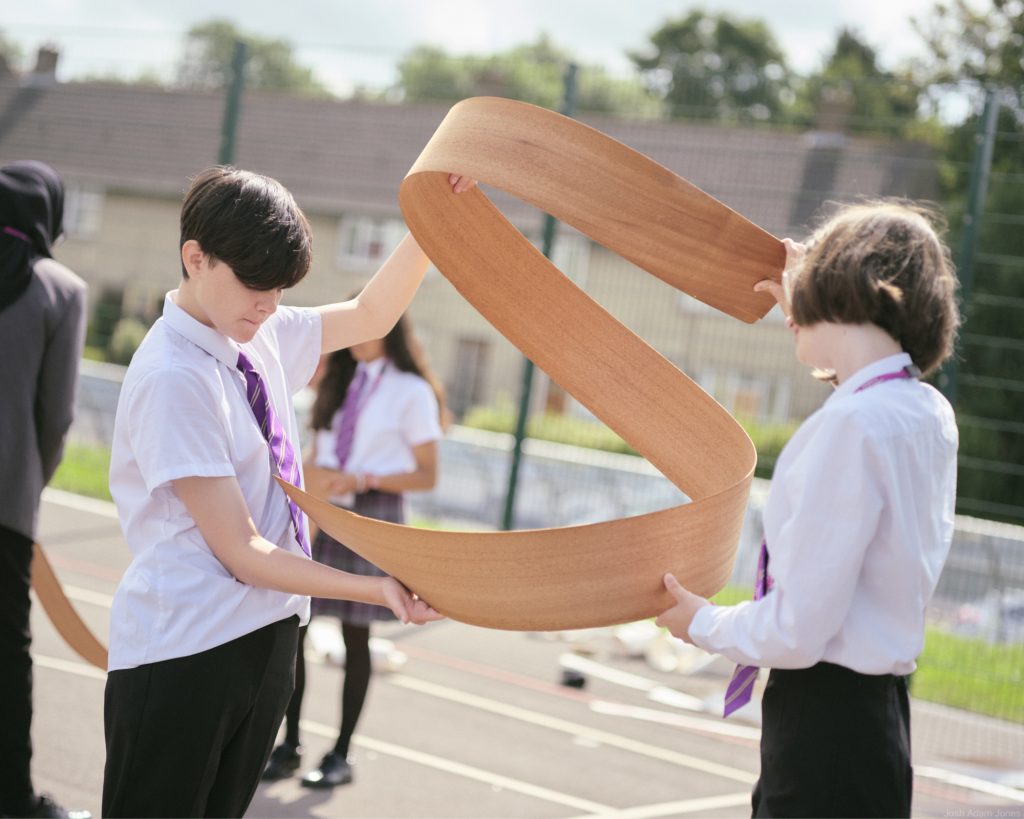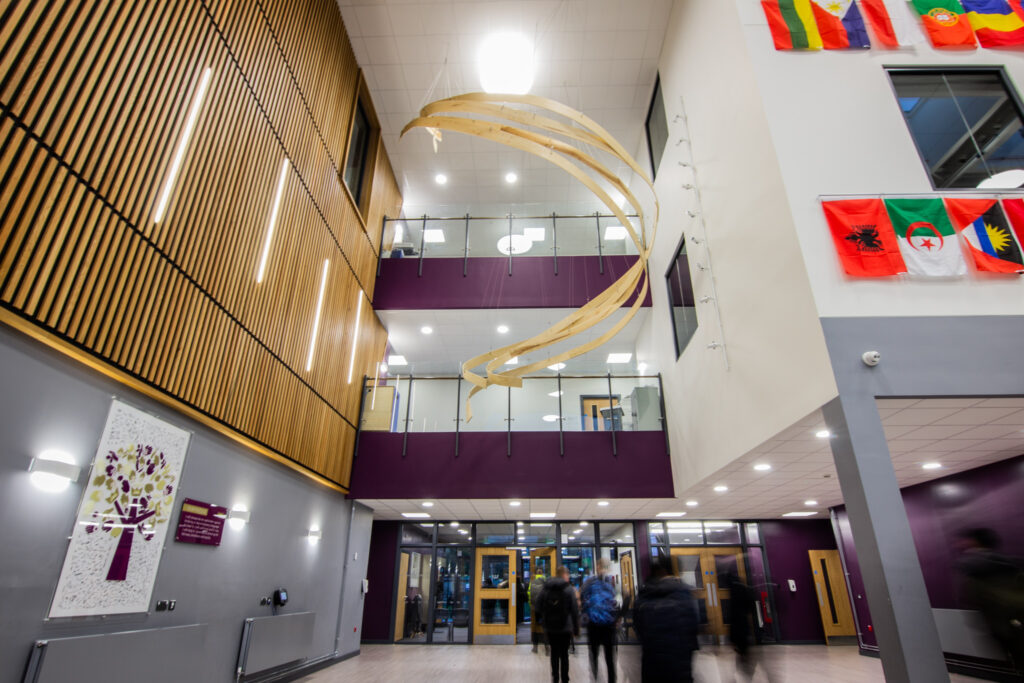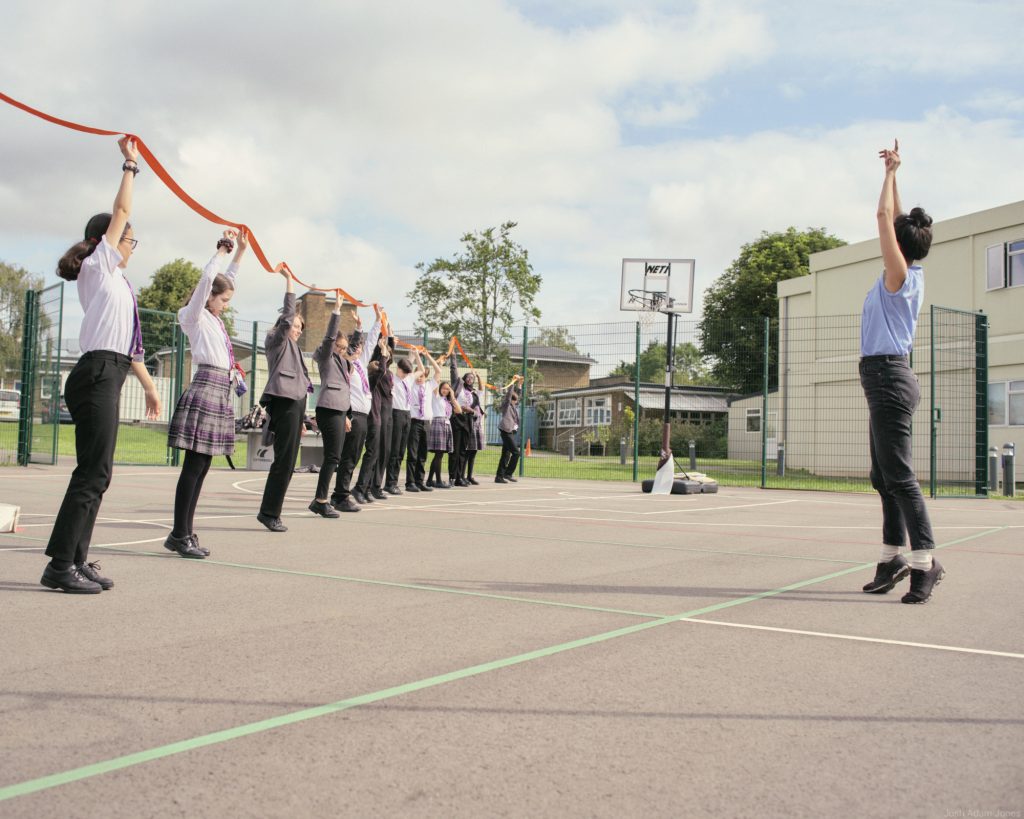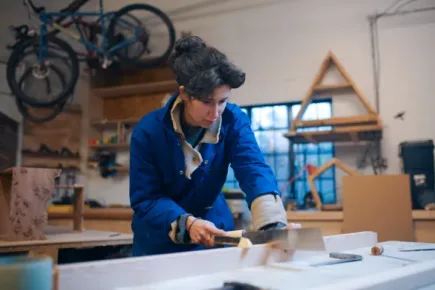Episode 13 – Synnøve Fredricks – The Tree, the music, and the students
November 2022, 30 mins
In this Bricks podcast episode, Rowan Bishop meets with Synnøve Fredericks and takes a walk around the beautiful trees of Bristol’s Ashton Court estate, discussing the process of creating the Trinity Vortex, her practice, her love of nature and the outdoors, and her hopes for the impact that the work will have.
With guest speakers Rhia Davenport, Hannah Parry, and Anne Rotzek.
Transcript: Please see at the end of the page.



In the podcast
-
Synnøve Frederick
Synnøve is a sensory designer, artist and maker.
Creating installations, sets and furniture that communicate emotion, orientation and story through the senses.
Co-Producer
TRANSCRIPT
Synnøve Fredericks
SPEAKERS
Rowan Bishop, Student 1, Student 2, Synnøve Fredericks
Rowan Bishop 00:04
Synnøve Fredericks is a sensory designer, artist and maker. She has specific interests in technology, the environment, process and materials, and she describes herself as ‘wishing to rekindle a sense of wonder through our senses.’ In 2021, Synnøve was commissioned by Bricks to create a new artwork for Trinity Academy, a new secondary school in Lockleaze, Bristol. Trinity wanted to work in creative collaboration with an artist to produce the work, which was to support and celebrate their creative spirit of heart, head and soul. I met with Synnøve later that year, and we walked around the beautiful trees of Bristol’s Ashton Court estate, to discuss the process of creating the work, her practice, her love of nature and the outdoors, and our hopes for the impact that the work will have.
Synnøve Fredericks 00:56
I’m Synnøve Fredericks, and I’m currently walking through Ashton Court to look for some trees. So, the project we’re doing at Trinity Academy. We’re building a sculpture together that holds the school ethos and intention, that’s going to be sort of designed with the students and to sort of bring everybody together within the main space. So we’ve selected a song, there’s music specialists who’ve gone into the school because of their specialism in music, got a gift of music, have selected several songs. And then we refined that down to choose one that holds the intention of the school. And then with that we’ve just, as a group, come together – people who beyond just music, they’re all into history and mathematics and the sciences, and art. We’ve all come together with all those different mediums and interests to listen carefully to the piece of music, then unpack the piece of music through sort of visualisations and words. And then taking that through movement, so that we could really see every angle of it. And then with that movement, and, and the words, and the visions that we’d seen, whilst listening to it, creating a form that holds that using steam bent timber. So it’s a sculpture, but it’s devised together with the students, with us as a group. The music specialists selected one or two, sometimes three songs, that they felt like fitted this brief that we given them around head, heart and soul. Also, this courage and willingness to explore and include all and it just came down to this one song which is very rousing it’s felt really encouraging, and yet really moved you which is really nice. And the songs, it’s actually a pop song that was redone by a sort of classical music duo called the Piano Guys. But it’s called ‘That Havens Five Secrets’. So since choosing the song, which all happened very quickly, actually, and was perfectly timed. We went straight into a workshop that was first, really just lying down and listening to the song from start to finish together. And then we listened to it again, I think it was after that, and listened to, saw what came up in our bodies, what we were seeing in our mind, what words came up, what we were listening to, which instruments were being played, and which sounds they were hearing, trying to sort of incorporate all of the senses into that. The feedback from the students to begin with was, it was actually that they weren’t quite sure what was happening because they’d never done anything like it before. And then I think it became a bit clearer about how we were eking out a form, a physical form, through the process, and actually just enjoyment and how playful it can be to devise something like that together. And using music, and other ways you can listen or interpret something.
Rowan Bishop 04:17
I attended one of the initial workshops that Synnøve was running with the students at what would become Trinity Academy. As the music played, they began moving around, nervously at first, but as the dynamics of the peace grew, they became more animated and that enthusiasm spread through the group, as Synnøve watched and sketched out sweeping shapes on a large piece of paper. During the debrief and discussion, towards the end of the session, the students spoke about how the music had made them feel and shared ideas that came up as they responded to the sounds echoing around the room.
Synnøve Fredericks 04:48
None of them? Ah that’s interesting.
Student 1 04:52
Because it’d be like growing, like growing, you know, like because as the music progresses, it’s actually it kind of was..
Student 2 05:00
It got like faster, louder.
Synnøve Fredericks 05:01
Growing is a great word. Let’s put that in. It’s nice, because we’re using timber as well.
Student 2 05:10
Like yesterday we were like, will we do something with wood that’s based on all of these points?
Synnøve Fredericks 05:15
Usually, like it’s good to get them all down, and then you can sort of refine it. I mean, that’s a really good point that we should probably share with everyone. I find it really helpful to get everything out of my system and then you choose what’s relevant. Yeah, but it’s nice to get out of your system together. Like right, this is what we all felt. Designing through devising, for me has been a really nice process, like using theatrical processes or different warmup techniques to kind of open up the group and get them speaking to each other, or finding a bit more confidence in themselves and their bodies, whilst having the conversation about a piece of music. And form, eventually forms just been. So ah, yeah, it’s great really works. Theatre is amazing, really powerful.
Rowan Bishop 06:12
As we trudge through the grass of Ashton Court, Synnøve would talk about the trees that we passed, their physical properties, and uses for them, in furniture making, art or medicine. I asked about her background, and what draws her to nature, as well as the connection between her work and the outdoors.
Synnøve Fredericks 06:27
I guess I spent a long time learning things about being outdoors and with nature, that asked my senses to work a little bit. So stuff like leather making, or even wood works out in woodlands, doing Greenwood work. Also, where you’d have to listen a bit into what the materials are saying to you, when they’re ready. You know, what are these other things that influence us, that it’s nice to become aware of? Most foraging is pattern, you know to look not with your eyes focused on one thing in particular, but having a wider view, you can start seeing patterns a bit better. Or the plants that you might find, just trying to think of an example right now, kind of like from this distance, where we’re in a field right now to be able to look further away and see just the shape of the trees, what shapes they’ve got, and the patterns that they make. I guess through the workshops, we’re doing both widely listening, and then honing down to some details about it. And actually, the final sculpture might be just one of the details that really held together a lot of the poetry that we’d found in it. I guess it’s also rhythms in the music and the quietness is and because they were very much inspired by Beethoven’s music, you could see the, you know, where things get very loud, when you’re listening to it starts quiet. And the comparison between both of those things, that contrast is really in there, that actually isn’t in quite a lot of pop music, contemporary music is quite consistent. Which is useful, because I always end up turning it up and then I get blown away at some point, the music goes far too loud. I always was fascinated and excited by plants and their complexity, elegance, beauty, they’re just natural, just naturally fantastic shapes and forms that are unparalleled. That took me to explore plants to learn as much as I could about being outdoors, about the qualities that they have, their medicinal values, and then just seeing how at some point we’ve lived, so harmoniously within this landscape with plants, including death, this is a harmony. And then I tried to learn as much as possible living in sort of equilibrium with surroundings. Very simply, it’s just how generous it can be when you start seeing what you can forage out of a space or, and how to do that mindfully or considerately and respectfully, so that you can come back next year, and it still be available. Yes, that took me lots of places, learning about green wood, which is a wonderful way to learn about the trees because you just like see how they grow, where they grow, what the quality of each tree is, in in their habitat, and as they grow, as they’re felled. What they’re like to work with. Some really solidify, you know, it can get so hard once it’s dried, but actually can be quite soft to work with when it’s green. Which is just such an amazing quality. These trees look so static, we all know they grow, they grow in slightly different time frame, they look so solid, and reliable. And there’s something about the flexibility of steam bending, which is really magic to see this plank of timber you just that, you know, usually I saw it in bits to be able to work with it, but this to be able to just flex it into its new shape. To follow something like a song, it’s just really exciting, I was excited by that.
Rowan Bishop 10:29
The final form of the sculpture will be made from steam bent wood, which is wrapped around the frame and left to set. I visited the boat yard where Synnøve was working on the final sculpture to check in on the process.
Synnøve Fredericks 10:42
This is the form that we’re going to wrap the steamed bits of timber around. And I’ve made it smaller than the size we’re aiming for because often when you’ve steamed timber, it springs out and will become a bigger radius than you were looking for. I guess it’s like this massive, it’s like a comb. Because it’s a tapered vortex that we’re making. And it’s really light so that we can move it around. And so I could transport it here and make it and put it together by myself or with the help of just one other person. Yeah, it’s just a form that we can clamp it to that’s circular and follows the structure that we’re going to make. And so it’s the process of heating up the timber, and the lignin within the timber. It’s just like a thermoplastic in that when you heat it, you can mould it. And once it’s cooled down, it will stay within that shape. And it’s used in boat building a lot, you know, when we used to build a lot of boats in timber, and some still are built and we do have like this historic boat yard in the centre of Bristol, who we’ll be working with to do the steam mending form itself. Which is really nice for me, because I don’t know everything about timber, there’s so much to know, it’s nice to have a place to go and be able to ask questions about it so that we can get it as we’d like it and make sure we’re not over visioning ourselves, if that’s the right way of putting it. It’s just a fantastic process. Some really lovely things can be done either just smooth forms, moving with the grain of the timber is really instructive that the way it moves. So either there’s flowing forms or maybe making patterns, regular patterns with it. So it looks like now we’re going to be using ash, because we’re going to have the peice inside. And we want sort of the greatest flexibility and ashes just got such beautiful long grain that it would it’s really on our side then to get the form that we’d like. It’s also a lovely pale colour. But that can be stained or moved in that way. And the grains just gorgeous. So this was felled two weeks ago, maybe.
Rowan Bishop 12:40
Where’s it from?
Synnøve Fredericks 12:43
Tyntesfield which is a National Trust site, and we had a sudden last minute change of plan. So we’ve been really kindly given this from Tyntesfield site that was milled up today in Chelvey in Backwell just outside of Bristol by a very skillful miller. I’m so glad that we could work with him because it was a tree with a bit of a bend in so it’s quite difficult to get all of the planks straight and the width that we’re looking for. So amazing really you managed to do enough. In the wintertime is quite a nice time to try finding them and and challenge yourself to find trees because it’s got these little black buds form on each the end of the branches. And they’re quite knobbly branches, they look a bit like my fingers, you know where your knuckles are. They’re just a little bit nobbly, on mine at least, and ash has a bit of that quality. And then also you might see some keys hanging off it in the wintertime you might see old ash keys just hanging there in the branches which would be a bit of a giveaway as well. Ash key is the kind of the seedlings that will fall and you can pickle them. I haven’t actually done that myself but but you can, Ash key pickle.
Rowan Bishop 14:38
The site where the sculpture will be installed has changed over time. Moving the work inside hopefully means that more people will experience it and therefore it should have more impact. Synnøve is thoughtful about the placement of the final piece and the effect that the location will have on how people encounter it.
Synnøve Fredericks 14:55
First I thought it might be outdoors – I would have loved that – but it just wasn’t quite the right spot for it. So it’s going indoors, onto a wall in this main space, just next to the performance area. So you know, if you’re arriving to see a performance, maybe just, you know, then you would go through this space and see this piece that we built together, before going into the specially built performance room. But also, as you’re going to come into school, in the morning, you’ll pass it, and you’ll have lunch, be able to view it and just saying how nice that that’s going to be to be able to live with an artwork like that. It’s just really precious. And I know that in my lifetime, they’re the things I’ve had the opportunity to spend time with that that has inspired me much later in life, you know, seeing how rivets work within this piece, or you know that you can steam bend timber at all, I think having access to that’s exciting. And something you didn’t think was possible as possible. Being able to sit and view it and know that somehow that infiltrates into your life. You know, it gives you solutions in the future, to see the way something’s been made. And to know the process that’s gone along with it. I think the form that it’s taking is starting to become this sort of vortex of movement first, beginning together growing outwards, it takes a lot of energy. I think it brings a lot of energy, and how they’re spiralling, moving, gathering speed and going out into the world in this new form. And it is the sort of pioneering students who first arrived who are, we’re working on that project together. And it’s quite nice to know they’re holding that space. And I think there’s something about doing that through a form that you can hold that space in a way that isn’t intellectualised Just through conversation, or words. It’s bringing in everything that they’re excited about at the school; music, movement, sharing, it’s very generous. It’s pretty incredible place. I was really like wow, they’re doing something brilliant. I want the students to take away an awareness of each other, and of how to work together and that you can create artworks together. It does all of all artworks, involve a lot of collaboration and the input of many people.
Rowan Bishop 17:21
Thanks for listening. We’re Bricks, a social enterprise with a mission to support creative communities in Bristol, helping them to thrive. We work with communities, developers and local artists to produce programmes that support both local voices and Bristol’s creative economy. In 2021, we delivered public art projects across a range of developments from hotels to new housing, neighbourhoods, schools, and listed community buildings. If you’d like to get in touch, learn more about Bricks public art producing or find out more about the artwork discussed in this podcast. Please visit Bricksbristol.org and follow us for updates on all the usual social channels. To be the first to hear when we release new podcast episodes, be sure to subscribe to our feed and if you enjoyed this episode, feel free to leave us a review. This podcast was produced by Rowan Bishop. The Trinity Academy public art project was commissioned by Bristol City Council as part of the planning application for Trinity Academy secondary school. Thanks to everyone on the creative Commissioning Group for their input.
END OF TRANSCRIPT.

